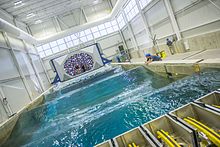Wave tank

A wave tank is a
Wave basin

A wave basin is a wave tank which has a width and length of comparable magnitude, often used for testing ships, offshore structures and three-dimensional models of harbors (and their breakwaters).
Wave flume
A wave flume (or wave channel) is a special sort of wave tank: the width of the
Wave flumes may be used to study the effects of
The waves are most often generated with a mechanical wavemaker, although there are also wind–wave flumes with (additional) wave generation by an air flow over the water – with the flume closed above by a roof above the free surface. The wavemaker frequently consists of a translating or rotating rigid wave board. Modern wavemakers are computer controlled, and can generate besides
Often, the side walls contain glass windows, or are completely made of glass, allowing for a clear visual observation of the experiment, and the easy deployment of optical instruments (e.g. by Laser Doppler velocimetry or particle image velocimetry).
Circular wave basin
In 2014, the first , circular, combined current and wave test basin, FloWaveTT was commissioned in The University of Edinburgh. This allows for "true" 360° waves to be generated to simulate rough storm conditions as well as scientific controlled waves in the same facility.
See also
Further reading
- Hughes, Steven A. (1993), Physical models and laboratory techniques in coastal engineering, World Scientific, ISBN 978-981-02-1541-5
References
- ^ Wave tank in The University of New Hampshire - Chase Ocean Engineering Lab
- ^ Information on the flume at the Forschungszentrum Küste research institute of the University of Hannover.
- ^ Ocean and Hydraulics Laboratory in KAJIMA Technical research Institute
- ISBN 9780521129954
- ^ Wave Lab at Department of Mathematics, ERAU-DB.
External links
 Media related to Wave flumes at Wikimedia Commons
Media related to Wave flumes at Wikimedia Commons
